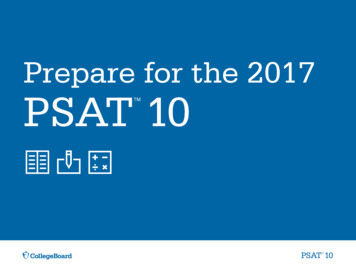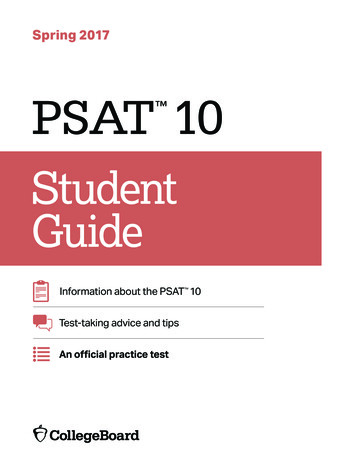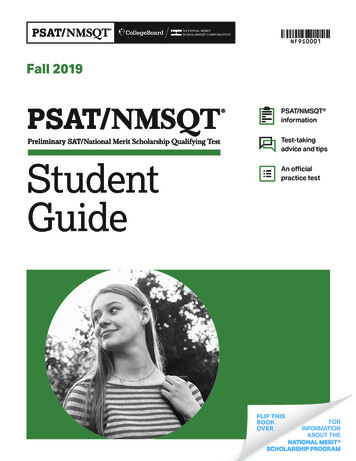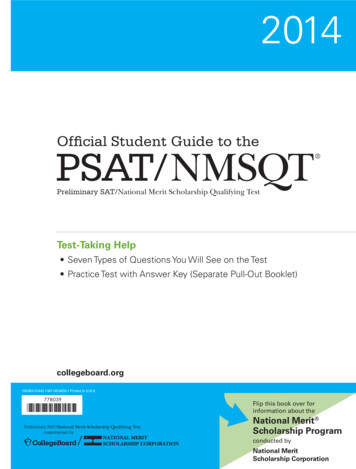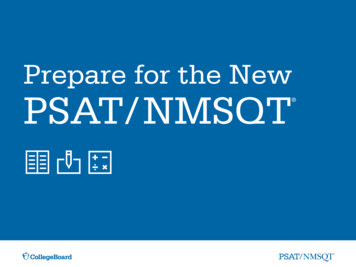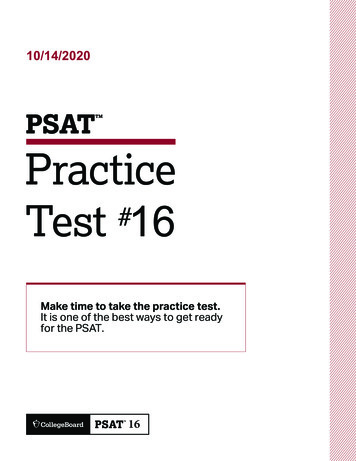
Transcription
10/1 /2020PSAT Practice#Test 1Make time to take the practice test.It is one of the best ways to get readyfor the PSAT.
11Reading Test60 MINUTES, 47 QUESTIONSTurn to Section 1 of your answer sheet to answer the questions in this section.DIRECTIONSEach passage or pair of passages below is followed by a number of questions. After readingeach passage or pair, choose the best answer to each question based on what is stated orimplied in the passage or passages and in any accompanying graphics (such as a table orgraph).e54zvcm33h7s66m9842n7w6ig2xyc2Questions 1-9 are based on the followingpassage.This passage is adapted from Maxine Clair, October Suite. 2001 by Maxine Clair.Line51015202530When she began occasionally calling herselfOctober, she was only ten years old. Others said itwas ridiculous, said she was nobody trying to besomebody. But she made convincing noises aboutgiven names, how you could give one to yourself,how it could be more like you than your real name.She never dared say she hated the name that herfather had saddled on her, never said the new namehad anything to do with the memory of her mother,who had lost her life. Instead she had mentioned allthe strange names of people they knew, likeDaybreak Honor, and a classmate’s aunt, Fourteen.The pastor of their church had named his daughterDainty. Usually that fact had made people stop andconsider.Then when she was girl-turned-grown-seventeen,struck by her own strangeness and by the whole ideaof seasons, she had put it on like a coat and fastenedit around her. October was her name.Midmorning, on a flaming day in that season—aSaturday—October sat in the upstairs kitchenette atPemberton House, sewing on her black iron Singer.It was 1950. She was twenty-three, and thanking herlucky stars for a room in the best house for Negrowomen teachers in Wyandotte County. Situated inUnauthorized copying or reuse of any part of this page is illegal.354045502the middle of the block on Oceola Avenue, thetwo-story white clapboard set the standard fordecent, with its deep front yard and arborlike peartrees, its clipped hedges and the painted wickerchairs on the porch.From her window she could look down on thebackyard and see Mrs. Pemberton’s preciousmarigolds bunched along the back fence, and in frontof them, a few wilting tomato plants and short rowsof collards that waited to be tenderized by the firstfrost in Mr. Pemberton’s garden.A few months before, on the very same June daythat Cora had pushed her to take advantage of thevacancy coming up at Pemberton House, OctoberBrown had knocked on the door, hoping. Word wasthat you had to know somebody. For her cadetteacher year at Stowe School, she had lived with theReverend Jackson and his wife. Not so bad, butfarther away and further down the scale of nice. Mr.Pemberton, in undershirt and suspenders, hadopened the door, but his wife, Lydia Pemberton—gold hoops sparkling, crown of silvery braids—hadinvited her in.“We don’t take nothin but schoolteachers,” Mrs.Pemberton had said. When October explained thatindeed, she was a teacher, Mrs. Pemberton hadlooked her up and down.“Whereabouts?”CONTINUE
155606570758085901And October had told her about her cadet year atStowe, her room at the Jacksons’ place, mentionedChillicothe, Ohio, where she had grown up, and—because Mrs. Pemberton had seemed unmoved anduninterested so far—spoken of her two aunts whohad raised her and her sister Vergie with good hometraining.“Y’all are getting younger every year. You knowany of the other girls here?” Mrs. Pemberton hadasked.October explained that Cora Joycelyn Jones hadbeen her lead teacher at Stowe, that they had becomegood friends. The mention of an establishedconnection to a recognized good citizen had finallysatisfied Mrs. Pemberton.“Follow me,” she said, and led October on atwo-story tour of hardwood floors and high ceilings,French Provincial sitting room (smoke blue), damaskdrapes and lace sheers, mahogany dining table thatcould comfortably seat twelve, at least, two buffets,china closets, curio cabinets full of whatnots.Upstairs, all the women’s rooms—Mrs. Pembertondid tap lightly before she charged in—had highlypolished mahogany or oak beds, tables, desks, quiltsor chenille bedspreads, no-nails-allowed paperedwalls. Photographs, though, on desks, and floorlamps and wing chairs, stuffed chairs, venetian blindsand valances. Then she showed her the kitchenette, alarger bedroom with a two-burner and a tiny iceboxand “you see the sun goes down right outside thatwindow right there.”And as they went back down the stairs, Mrs.Pemberton told her in no uncertain terms thatnobody under their roof smoked or drank, and thatno men were allowed upstairs, but that the womencould “have company” in the sitting roomdownstairs. Yes, October understood.Yes, she was lucky to have her kitchenette.1In the passage, people react to October’s decision torename herself byA) praising her originality.B) admitting that they are jealous of her new name.C) criticizing her as arrogant.D) urging her to choose another name instead.2At line 20, the focus of the passage shifts fromA) an analysis of a key decision made by a characterto a summary of its consequences.B) a description of how a character perceives herselfto a description of how others perceive her.C) an affectionate portrait of a character to anobjective survey of her interactions with others.D) a brief account of a character’s youth to a moredetailed discussion of her adult life.3Which choice provides the best evidence thatOctober had originally been uncertain about whethershe could secure a room in Pemberton House?A) Lines 25-30 (“Situated . . . porch”)B) Lines 37-41 (“A few . . . somebody”)C) Lines 41-44 (“For her . . . nice”)D) Lines 49-52 (“We don’t . . . down”)4As used in line 57, “unmoved” most nearly meansA) unimpressed.B) immobile.C) heartless.D) unspoken.Unauthorized copying or reuse of any part of this page is illegal.3CONTINUE
1158In the eleventh paragraph (lines 69-84), thedescription of the rooms in Pemberton House servesmainly toWhich choice provides the best evidence for theanswer to the previous question?A) confirm that October and Mrs. Pemberton havesimilar tastes.B) Lines 64-68 (“October . . . Mrs. Pemberton”)C) Lines 69-74 (“Follow . . . whatnots”)A) Lines 54-60 (“And October . . . training”)B) establish that the house is well kept and carefullyfurnished.C) contrast the bedrooms with the rest of the house.D) Lines 85-90 (“And as . . . downstairs”)D) justify October’s sense of alienation amid hernew surroundings.9In context, the repetition of the word “yes” in lines90-91 serves mainly toA) reiterate October’s long-term plans to live atPemberton House.6The details of how Mrs. Pemberton enters the roomsupstairs serve mainly toB) illustrate a shift in October’s attitude towardMrs. Pemberton.A) portray her as somewhat unconcerned with hertenants’ privacy.C) underscore October’s satisfaction with therealities of life at Pemberton House.B) illustrate how her actions conflict with herprofessed ideals.D) emphasize Mrs. Pemberton’s intolerance ofviewpoints differing from her own.C) demonstrate that she feels personal affection forher tenants.D) stress her impatience with formalities and socialcustoms in general.7Based on the passage, which choice best identifies anonnegotiable condition for residing at PembertonHouse?A) Belonging to a family in good standing in thecommunityB) Being recommended to Mrs. Pemberton by otherresidents of the houseC) Abiding by certain notions of personalrespectabilityD) Taking care to preserve the historical features ofthe houseUnauthorized copying or reuse of any part of this page is illegal.4CONTINUE
11Questions 10-18 are based on the followingpassage and supplementary material.This passage and accompanying figure are adapted fromBharat Anand, The Content Trap: A Strategist’s Guide to DigitalChange. 2016 by Bharat Anand. The author discusseschanges in the music industry that began in the 1990s.Line51015202530354045To understand the relation between music CDsand concerts, it’s useful to first return to one of thecentral ideas in business strategy: the idea ofcomplements. It’s a simple idea, first coined a longtime ago, and popularized recently by the economistsAdam Brandenburger and Barry Nalebuff. It goeslike this: Two products are complements if a user’svalue from consuming both is greater than the sumof her values from consuming each alone.In other words, sell two complements togetherand a consumer will pay more for each than if theywere sold individually.Take hot dogs and ketchup. Each without theother isn’t particularly enjoyable. Have them togetherand you’re in grilled nirvana.One way to think about complements is that thevalue of one product depends on the availability ofanother—as with hot dogs and ketchup. Butcomplementary relationships can be stated in termsof price effects, too: Specifically, the demand for aproduct goes up when the price of its complementgoes down.What does this all mean for the music business?To start, note that CDs and concerts arecomplements. The cheaper one of them becomes(and therefore the more it’s consumed), the greaterthe demand for the other. For many years concertswere the cheap complement that boosted CD sales.But as the price of recorded music fell, more fanscould afford it—and were then drawn to liveconcerts.Before the rise of the Internet, concerts wereeffectively “advertising” CD sales. After the explosionin file sharing,1 the relationship effectively reversed:Free recorded music became the advertisement—andas a result, the ideal complement—for live concerts.Concert promoters are quite forthright about thisreversal. A senior vice president of AEG Live, one ofthe world’s largest presenters of live music events,said, “As the recording business has gotten hit byUnauthorized copying or reuse of any part of this page is illegal.50556065707580piracy, the fact that a lot of bands are getting playedall over the Internet on sites like Myspace andYouTube that are exposing music—we’re thebeneficiaries, in all honesty.”Concerts aren’t the only complement to recordedmusic. There are many others. To see where theyreside, return to ask the basic question regardingcomplements. As the price of music declines, whichare the music-related products, services, oraccessories that might benefit from this pricedecline? Music complements, it turns out, are manyand varied. To start, there were CD burners,2 blankCDs, and CD players; MP3 players became a leadingcomplement in subsequent years. And then there’sbroadband access: As demand for file sharingincreased (and with it, the loss in content sales forrecording studios) so did demand for high-speedInternet (and with it, a dramatic increase in revenuesfor Internet service providers and cable operators).Ask a music industry executive about theindustry’s challenges and you’re likely to hear that“young people don’t pay for products anymore.” It’sa common refrain, often used to bemoan why theeconomics of so many digital businesses have turnedsouth. But it’s wrong.As a recording studio executive, if you define yourbusiness in terms of how many CDs you sell, you’llbe right to berate the young. Define your business asmusic and all its complements—MP3 players,concerts, merchandising, broadband, and so on—and you’ll realize that young people are spendingmore than ever.The music industry is far from dead. Quite thecontrary. Billions of dollars of value were createdwithin the music industry during the recent decade.It’s just that value has been redistributed—fromrecording studios to artists, from music retailers totechnology manufacturers, from CDs to liveconcerts. The value shifted from recorded music toits complements.1 Transmitting files from one computer to another over theInternet2 A device used to record data to a CD5CONTINUE
111012Over the course of the passage, the main focus shiftsfromIt can most reasonably be inferred from the passagethat one implication of the idea of complements isthatA) an exploration of how a business approach wasdeveloped to an examination of how theapproach has been modified.A) consumers will spend more on complementaryproducts only if they initially valued one of thoseproducts individually.B) a definition of a business strategy to aconsideration of why that strategy has beenslowly declining in a particular business.C) an explanation of a business concept to adiscussion of how the concept has operated in aspecific context.B) the creation of new kinds of complementaryproducts may increase consumer interest inalready existing products.C) a wider availability of complementary productscan sometimes overwhelm consumers with toomuch choice.D) a presentation of the history of a business idea toan analysis of why the idea continues to berelevant today.D) sales in an industry that uses a variety ofcomplements in its business strategy will surpasssales in an industry that does not usecomplements.11As used in line 30, “drawn to” most nearly meansA) invited to.B) marked by.C) attracted to.D) deduced from.Unauthorized copying or reuse of any part of this page is illegal.6CONTINUE
111317Which choice provides the best evidence for theanswer to the previous question?The figure suggests that the overall increase in salesin the music industry from 1990 to 2014 can beexplained because sales fromA) Lines 16-22 (“One . . . down”)A) CDs/vinyl/tape increased more than sales fromconcerts decreased.B) Lines 23-25 (“What . . . complements”)C) Lines 25-27 (“The cheaper . . . other”)B) AAC digital format increased more than salesfrom AAC digital format (from smartphone)decreased.C) AAC digital format increased more than salesfrom all other complements combineddecreased.D) Lines 32-36 (“Before . . . concerts”)14As used in line 58, “dramatic” most nearly meansD) all complements combined increased more thansales from CDs/vinyl/tape decreased.A) impressive.B) theatrical.C) vivid.D) emotional.18The figure supports which conclusion regarding themusic industry in the years 2006 and 2014?15A) Although the sales from individual complementswere different in 2006 and in 2014, the total salesin the music industry as a whole wasapproximately the same in both years.It can most reasonably be inferred from the passagethat the health of the music business has generallybeen viewed as dependent on theA) popularity of the performing arts as a whole.B) Although the total sales from concert tickets in2006 was about the same as the total sales fromAAC digital format in 2014, the total sales fromCDs/vinyl/tape was greater in 2006 than it was in2014.B) consumer behavior of young listeners.C) number of websites devoted to digital music.D) degree of variety among musical complements.C) Although the total sales in the music industrywas greater in 2014 than it was in 2006, thenumber of complements contributing to thosesales was greater in 2006 than it was in 2014.D) Although the total sales from all complements inthe music industry was greater in 2014 than itwas in 2006, the proportion of individualcomplements sold during those years remainedconstant.16Which choice provides the best evidence for theanswer to the previous question?A) Lines 48-51 (“As the . . . decline”)B) Lines 51-54 (“Music . . . years”)C) Lines 54-59 (“And then . . . operators”)D) Lines 60-65 (“Ask . . . south”)Unauthorized copying or reuse of any part of this page is illegal.7CONTINUE
11Questions 19-28 are based on the followingpassage.45This passage is adapted from Sid Perkins, “Scientists SolveMystery of ‘Chinese Pompeii.’” 2014 by AmericanAssociation for the Advancement of Science.Line51015202530354050Scientists have long marveled at the immaculatelypreserved fossils unearthed from ancient lakesediments in northeastern China. The formercreatures—including fish, birds, small dinosaurs, andmammals—still sport the outlines of muscles, skin,and feathers thanks to the fine-grained volcanic ashthat blanketed the carcasses and then hardened intorock. Now, new analyses of the remains show thatthe material that entombed the animals also killedthem, overwhelming them in a hot cloud of ash akinto the one that destroyed the Roman city of Pompeiinearly 2000 years ago.The so-called Jehol fossils, named after a mythicalland of Chinese folklore, date to between 120 millionand 130 million years ago and are noteworthy in anumber of ways. Besides their remarkablepreservation, which even saved traces of delicatestructures like air bladders in fish, researchers haveoften found an unexpected juxtaposition of creaturesin the same layer of ancient lake sediment. Smalldinosaurs such as Psittacosaurus and birds suchas Confuciusornis lie next to fish, for example.Scientists have long speculated that this odd mix wasa sign of mass catastrophe, says Baoyu Jiang, asedimentologist at Nanjing University in China, butthey weren’t sure how it could have occurred. Also amystery, he notes, is how the relatively undamagedcarcasses of land animals—especially those of birds,whose remains typically float and are fragile due totheir light bones—ended up intact at the bottom ofa lake.Now, Jiang and his colleagues have taken a closerlook at the Jehol fossils—literally. Researchers havelong noted that the remains of soft tissues were oftensheathed in a thin, dark carbon-rich layer. But theteam found that under the microscope, cells in thetissues of fossils from several sites had been blownopen, and they had a charcoal-like appearance. Inaddition, the surfaces of bones often showed adistinct sort of cracking typically seen only when aliving or freshly dead creature is exposed to intenseheat, Jiang says. The postures of the Jehol fossils, withmuscles and tendons contracted, is also a clue thatthe carcasses were exposed to extreme heat. But theUnauthorized copying or reuse of any part of this page is illegal.5560657075fossils of fish don’t appear to show this heat relateddamage.Altogether, the evidence suggests that the landanimals entombed in the ancient Chinese lakes werekilled by a hot cloud of volcanic ash that then sweptthem into the lake, the researchers report. What isnow northeastern China was rife with volcanicactivity at the time, Jiang says. Although it’s possiblethat flying birds could have been overcome bypoisonous volcanic gases and fallen directly into theancient lakes, that doesn’t explain how the othernonaquatic animals got there, he says. It’s not likelythat the carcasses were carried into the lakes bystreams, Jiang explains, because that would havedamaged the remains. Also, he notes, the fossilswould have been surrounded by silt or mud ratherthan fine-grained volcanic ash. Although scientistshad previously noted the Jehol fossils weresurrounded by tiny bits of volcanic rock, they hadn’tlinked the ash to the death of the creatures; they’donly suggested that the fine-grained materialcoincidentally rained down to blanket a normallake-bottom accumulation of dead creatures,Jiang says.The evidence uncovered by Jiang and hiscolleagues “is very convincing,” says Janet Monge, ananthropologist at the University of PennsylvaniaMuseum of Archaeology and Anthropology who hasstudied the remains unearthed at Pompeii. TheChinese fossils “have a very particular type offracture pattern, a classic example of bone failureassociated with extreme heat,” she notes. “I’ve neverseen anything like it outside of Pompeii.”19Which choice best describes the overall structure ofthe passage?A) A back-and-forth dialogue between expertssupporting different theoriesB) A series of descriptions of a theory’s successfulapplication to several different phenomenaC) A review of known information, a presentationof new information, and an analysis of variousexplanationsD) A summary of an experimental technique, anacknowledgment of its limitations, and aconsideration of an alternative8CONTINUE
112023The main purpose of the second paragraph(lines 13-31) is to describe theAccording to the passage, the cracking observed onthe bone surfaces of the Jehol fossils occurredA) history behind the naming of certain fossils.A) when the bones were at the bottom of a lake.B) challenges of working with certain fossils.C) first of two theories regarding the origin ofcertain fossils.B) as a result of pressure from layers of silt, mud,and ash.C) primarily in the bones of birds and fish.D) surprising locations of certain fossils.D) when the organisms were either alive or recentlydeceased.2124In the context of the passage as a whole, a key detailgiven in the third paragraph (lines 32-46) is that theresearchersWhich choice best supports the idea that thewell-preserved nature of the Jehol fossils enabledJiang and his colleagues to identify evidence of howthe organisms died?A) observed characteristics of the fossils thatindicated that the organisms had been exposedto extreme heat.A) Lines 42-44 (“The postures . . . heat”)B) noted that the grouping of the fossilizedorganisms was unlike that seen at other sites.B) Lines 50-52 (“What . . . says”)C) studied the effects of river transport on fossils ofbirds, fish, and land animals.D) Lines 69-73 (“The evidence . . . at Pompeii”)C) Lines 52-56 (“Although it’s . . . says”)D) developed novel methods of nondestructiveremoval of dinosaur fossils from layers of silt andmud.25Which finding, if accurate, would most weaken Jiangand his colleagues’ claim that the Jehol organismswere swept into the lake by a hot cloud of volcanicash?22As used in line 35, “sheathed” most nearly meansA) Gases trapped in the Jehol lake sediments arefound to be nontoxic.B) Bird fossils are found in the Jehol lake sediments.A) carried.B) coated.C) stored.C) Damaged fossils of land animals are discoveredin Jehol lake sediments.D) provided.Unauthorized copying or reuse of any part of this page is illegal.D) One of the Jehol lake sediments is found to haveformed approximately 125 million years ago.9CONTINUE
11Questions 29-38 are based on the followingpassages.26Which choice provides the best evidence for theanswer to the previous question?Passage 1 is adapted from Dwight D. Eisenhower’s 1955remarks to the National Association of Radio and TelevisionBroadcasters. Passage 2 is adapted from a 1958 speech byEdward R. Murrow. 1958 by the Estate of Edward R.Murrow. Eisenhower was president of the United States.Murrow was an American broadcast journalist.A) Lines 35-38 (“But the team . . . appearance”)B) Lines 44-46 (“But the fossils . . . damage”)C) Lines 56-59 (“It’s not . . . remains”)D) Lines 61-68 (“Although . . . says”)27The main purpose of the phrase “rained down” inline 66 is to emphasize theLine5A) high speed at which the ash cloud moved.B) large quantities of falling ash.C) intermittent nature of the eruptions.D) distinct possibility that ash mixed with water.102815In the passage, Janet Monge’s response to Jiang andhis colleagues’ work can best be described as that ofA) a skeptic who ultimately endorses Jiang’sfindings.B) an expert who believes that Jiang’s theories havemerit.20C) a novice who is grateful for the opportunitiesthat Jiang has provided.D) a collaborator who provides an interpretation ofJiang’s observations.253035Unauthorized copying or reuse of any part of this page is illegal.10Passage 1One of the things that has made us an informedpublic is the fact that we have had a free press, andnow these great institutions, the radio and thetelevision, have moved in to take their placealongside the older media of mass communications.There is a tremendous responsibility here—insome ways, I think, transcending that that is placedbefore the publisher. The publisher puts in yourhome a piece of print. It is essentially cold—although, of course, we admit that some writers havean ability to dress it up and make even disagreeablefacts at times look fairly pleasant. But with thetelevision or with the radio, you put an appealingvoice or an engaging personality in the living roomof the home, where there are impressionable peoplefrom the ages of understanding on up.In many ways therefore the effect of your industryin swaying public opinion, and I think, particularlyabout burning questions of the moment, may be evengreater than the press. . . . It is something different,and you do introduce personality as well as cold fact.I think, again, that places added responsibility to seethat the news, in those areas of the radio andtelevision field that have to do with the disseminationof facts, is truthfully told, with the integrity of theentire industry behind it.I once heard an expression with respect tonewspaper standards: the newspaper columns belongto the public and the editorial page belongs to thepaper. And, for myself, I find that an easy standard tofollow and to apply as I examine a newspaper. Ishould think that some such standard could bedeveloped among you. Of course you want toentertain. Of course you want people to look at it,and I am all for it. And I think everybody else is. Butwhen we come to something that we call news—andI am certain that I am not speaking of anything youhaven’t discussed earnestly among yourselves—let usCONTINUE
1404550556065707580851simply be sure it is news. Let all of the rest of the timebe given to entertainment or the telling of stories orthe fanciful fairy tales that we sometimes find inother portions of publications.90Passage 2One of the basic troubles with radio and televisionnews is that both instruments have grown up as anincompatible combination of show business,advertising and news. Each of the three is a ratherbizarre and demanding profession. And when youget all three under one roof, the dust never settles.The top management of the networks, with a fewnotable exceptions, has been trained in advertising,research, sales or show business. But by the nature ofthe corporate structure, they also make the final andcrucial decisions having to do with news and publicaffairs. Frequently they have neither the time nor thecompetence to do this. It is not easy for the samesmall group of men to decide whether to buy a newstation for millions of dollars, build a new building,alter the rate card, buy a new Western, sell a soapopera, decide what defensive line to take inconnection with the latest Congressional inquiry,how much money to spend on promoting a newprogram, what additions or deletions should be madein the existing covey or clutch of vice-presidents, andat the same time—frequently on the same longday—to give mature, thoughtful consideration to themanifold problems that confront those who arecharged with the responsibility for news and publicaffairs.Sometimes there is a clash between the publicinterest and the corporate interest. A telephone callor a letter from the proper quarter in Washington istreated rather more seriously than a communicationfrom an irate but not politically potent viewer. It istempting enough to give away a little air time forfrequently irresponsible and unwarranted utterancesin an effort to temper the wind of criticism.Upon occasion, economics and editorialjudgment are in conflict. And there is no law whichsays that dollars will be defeated by duty. Not so longago the President of the United States delivered atelevision address to the nation. He was discoursingon the possibility or probability of war between thisnation and the Soviet Union and CommunistChina—a reasonably compelling subject. Twonetworks, CBS and NBC, delayed that broadcast foran hour and fifteen minutes. If this decision wasUnauthorized copying or reuse of any part of this page is illegal.dictated by anything other than financial reasons, thenetworks didn’t deign to explain those reasons. . . . Itis difficult to believe that this decision was made bymen who love, respect and understand news.29Based on Passage 1, Eisenhower would most likelyagree that typical viewers of broadcast newsA) are strongly opposed to efforts to turn facts intoentertainment.B) might be too easily influenced by a likeable andpersuasive newscaster.C) would rather get news from print sources thanfrom television or radio.D) are indifferent as to whether most newscastersare well trained as journalists.30Which choice provides the best evidence for theanswer to the previous question?A) Lines 12-16 (“But with . . . on up”)B) Lines 20-21 (“It is . . . fact”)C) Lines 22-26 (“I think . . . behind it”)D) Lines 33-34 (“Of course . . . entertain”)31Which claim about editorial standards in printjournalism and in broadcast journalism is implied byEisenhower in Passage 1?A) Neither print journalism nor broadcastjournalism has been able to adapt their editorialstandards to a changing news environment.B) The editorial standards for print journalism aresomewhat outmoded compared with thestandards that prevail in radio and television.C) Rigorous editorial standards are enthusiasticallyendorsed by executives in both print andbroadcast journalism.D) Broadcast journalism has not yet establishedadequate editorial standards for presenting thenews in the way that print journalism has.11CONTINUE
113235Which choice provides the best evidence for theanswer to the previous question?As used in line 87, “dictated” most nearly meansA) Lines 27-30 (“I once . . . paper”)B) spoken.C) determined.A) transcribed.B) Lines 30-31 (“And, for . . . newspaper”)C) Lines 31-33 (“I should . . . you”)D) confirmed.D) Lines 34-35 (“Of course . . . else is”)3633An important difference between the two passages’respective discussions of broadcast news is thatunlike Eisenhower in Passage 1, Murrow in Passage 2As used in line 67, “charged with” most nearly meansA) entrusted with.A) identifies key differences between printjournalism and broadcast news.B) assaulted with.C) assessed for.D) accused of.B) assumes financial considerations play only aminor role in the news business.C) sees a conflict between news values andentertainment values.34D) explains how the development of the broadcastnews business has shaped that industry.In Passage 2, lines 70-73 (“A telephone . . . viewer”)s
PSAT Practice Test #1 Make time to take the practice test. It is one of the best ways to get ready for the PSAT. . Free recorded music became the advertisement—and as a result, the ideal complement—for live co
